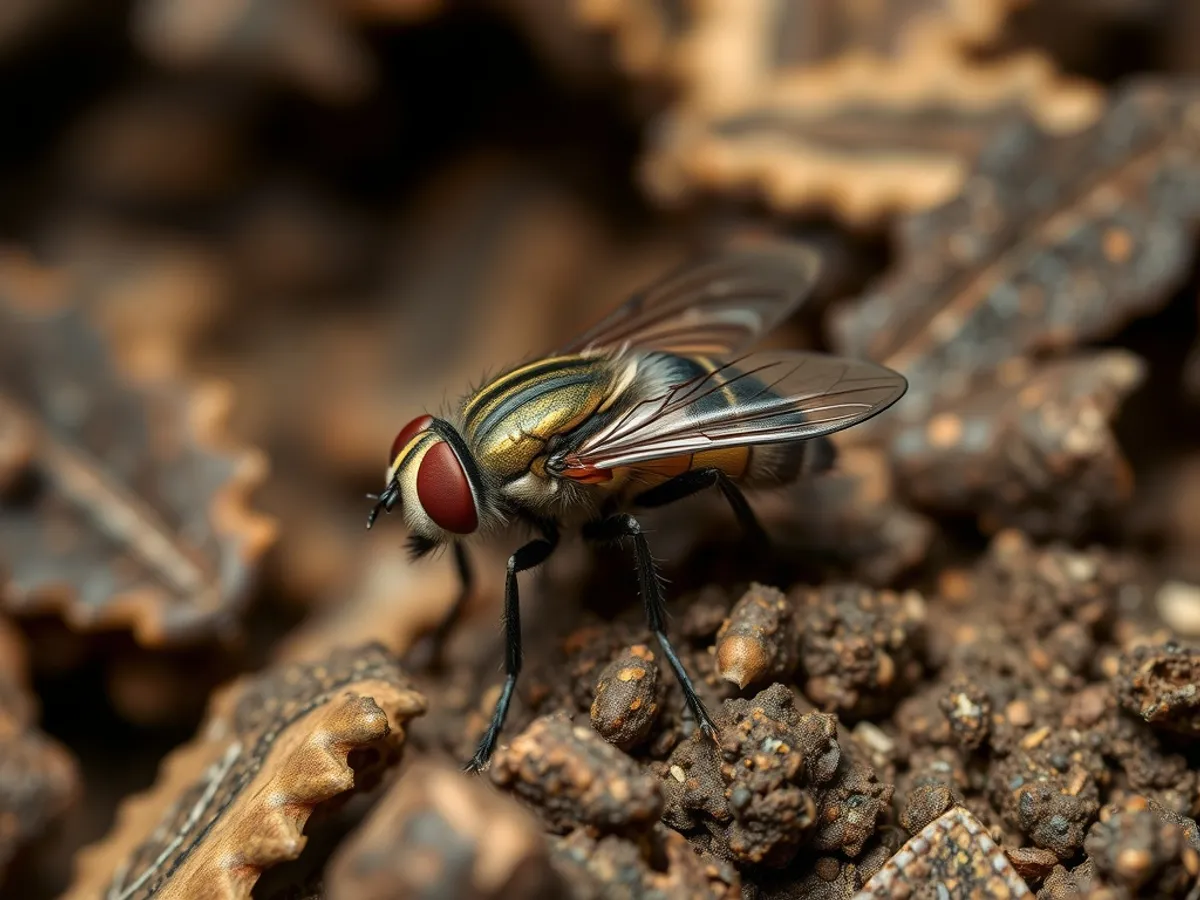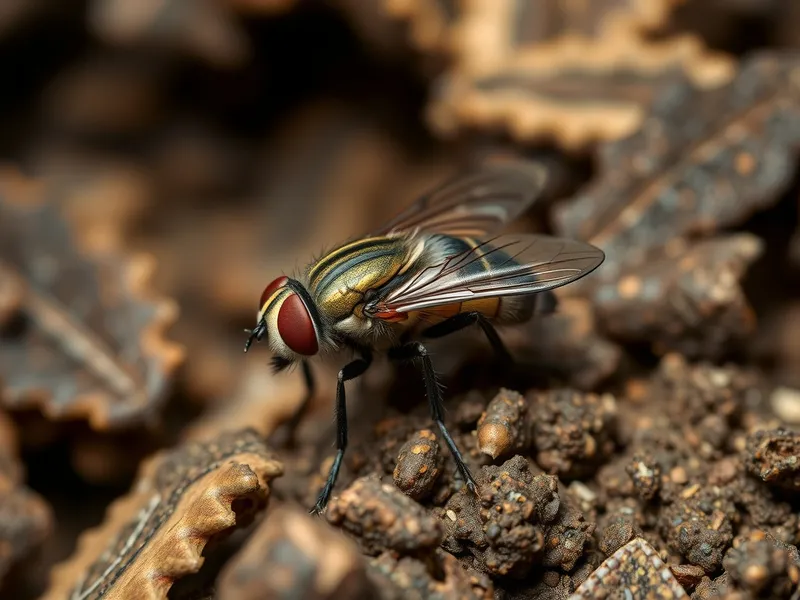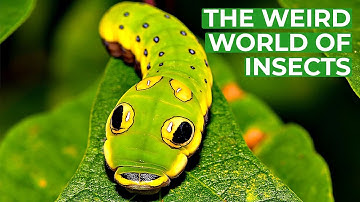
Common housefly
Musca domestica

Meet the Common housefly
The common housefly is a small, widespread insect found in human dwellings across the globe. It is easily recognized by its gray thorax with four dark longitudinal stripes and slightly hairy body, measuring about 6 to 7 mm in length. Houseflies are notorious for their rapid breeding cycle and their association with human environments, where they feed on a variety of organic matter. They play a significant role in the transmission of various pathogens, making them a concern for public health.
Classification
Invertebrate
Habitat
Human habitations, farms, and areas with decaying organic matter
Diet
Omnivore
Lifespan
15-30 days
Conservation
Least Concern
Weight
8-12 mg
📖Fascinating Facts
Rapid Life Cycle
A housefly’s entire life cycle, from egg to adult, can be completed in as little as 7-10 days under optimal conditions.
Tasting with Feet
Houseflies have chemoreceptors on their tarsi (feet), enabling them to taste whatever they land on instantly.
Disease Spreaders
Houseflies can mechanically transmit dangerous pathogens like Salmonella, E. coli, and cholera by picking them up on their bodies and depositing them on human food and surfaces.
📋Detailed Description
The common housefly (Musca domestica) is a synanthropic insect, meaning it thrives in close association with humans and their activities. Adult houseflies typically measure 6–7 mm in length, with females generally larger than males. Their anatomy is characterized by a gray thorax marked with four distinct longitudinal black stripes, a slightly yellowish abdomen, and large, reddish compound eyes that provide a wide field of vision. The mouthparts are adapted for sponging up liquids, as houseflies cannot bite or chew solid food; instead, they secrete digestive enzymes onto food to liquefy it before ingestion. Their wings are transparent and held flat over the back when at rest, allowing for agile, rapid flight with a wingbeat frequency of up to 200 times per second. Houseflies possess short, bristly antennae and fine hairs (setae) covering their bodies, which enhance their sensory perception. The legs are equipped with sticky pads (pulvilli) and claws, enabling them to walk on smooth vertical surfaces and ceilings. Houseflies are holometabolous insects, undergoing complete metamorphosis with distinct egg, larval (maggot), pupal, and adult stages. Their life cycle is remarkably rapid, allowing populations to explode under favorable conditions. As generalist feeders and prolific breeders, houseflies are highly adaptable and occupy a wide range of ecological niches in human-altered environments.
💡 Did you know?
Houseflies can carry and transmit over 100 different pathogens, including bacteria, viruses, and parasites, simply by landing on surfaces or food.
🔬Research & Sources
🎭Behavior & Social Structure
Houseflies are diurnal, exhibiting peak activity during daylight hours, particularly in warm, humid conditions. They are strong fliers, capable of traveling several kilometers in search of food or breeding sites, though they usually remain close to their birthplace if resources are abundant. Feeding behavior is opportunistic; houseflies are attracted to a variety of organic materials, including decaying matter, feces, and human food. They use their labellum (sponging mouthpart) to sample surfaces, often regurgitating digestive fluids to pre-digest food. Houseflies display grooming behavior, frequently cleaning their legs, wings, and head to maintain sensory function and remove debris. Social interactions are generally limited to aggregation around food sources or breeding sites, with little evidence of cooperative behavior. Houseflies exhibit negative phototaxis at night, seeking dark resting places, and positive phototaxis during the day, being drawn to light and warmth. They are also highly responsive to movement, which aids in predator avoidance.
👶Reproduction & Life Cycle
Reproduction in Musca domestica is prolific and rapid. Mating typically occurs within a few days of adult emergence, often initiated by the male mounting the female after a brief courtship involving wing vibrations and antennal contact. Females can store sperm from a single mating to fertilize multiple batches of eggs. A single female may lay up to 500 eggs in her lifetime, usually in batches of 75–150, deposited in moist, nutrient-rich substrates such as manure, garbage, or decaying organic matter. The eggs hatch within 8–24 hours, depending on temperature, into legless larvae (maggots). Larval development lasts 3–7 days, during which maggots feed voraciously and molt through three instars. Pupation occurs in a protective case (puparium) formed from the last larval skin, lasting 2–6 days. The entire life cycle from egg to adult can be completed in as little as 7–10 days under optimal conditions (25–30°C), enabling multiple generations per season. There is no parental care; all developmental stages are independent after egg laying.
🛡️Adaptations & Survival
Houseflies exhibit several adaptations for survival in human environments. Their rapid reproductive cycle and high fecundity allow for swift population growth, even in transient habitats. The sponging mouthparts enable them to exploit a wide range of liquid and semi-liquid food sources. Their compound eyes provide nearly 360-degree vision, detecting movement and aiding in predator evasion. The pulvilli on their feet secrete a sticky substance, allowing them to adhere to smooth surfaces and evade capture. Houseflies are highly resistant to desiccation due to their waxy cuticle, and their larvae can tolerate a range of organic substrates, including those with high microbial loads. Behavioral plasticity, such as shifting activity patterns in response to temperature and humidity, further enhances their adaptability. Evolutionary resistance to various insecticides has also been documented, attributed to genetic mutations and metabolic detoxification mechanisms.
📚Research Sources
🎨Cultural Significance
The housefly has featured prominently in human culture, often symbolizing filth, decay, and pestilence due to its association with waste and disease. In ancient Egyptian mythology, flies were awarded as military decorations for bravery. In literature and art, houseflies have been used metaphorically to represent annoyance, transience, or the ubiquity of death and decay. Some traditional medicine systems have used maggots (larvae) for wound debridement, a practice now recognized as maggot therapy in modern medicine. Houseflies also play a role in forensic entomology, where their developmental stages help estimate post-mortem intervals in criminal investigations.
🔬Recent Research & Discoveries
Recent research on Musca domestica has focused on its role as a vector for antimicrobial-resistant bacteria, with studies revealing carriage of multidrug-resistant strains in urban and agricultural settings. Advances in genomics have led to the sequencing of the housefly genome, providing insights into genes linked to detoxification, immunity, and sensory perception. Studies on insecticide resistance mechanisms are ongoing, aiming to develop more sustainable pest management strategies. Behavioral research has explored housefly learning and memory, revealing basic associative learning capabilities. Additionally, investigations into the microbiome of houseflies have highlighted their role in the horizontal transfer of pathogens and antibiotic resistance genes. Emerging research also examines the potential of housefly larvae as a sustainable protein source for animal feed and waste bioconversion.
🎥Wildlife Videos

Facts About Flies - Secret Nature | Fly Documentary | Natural History Channel
There's no two ways about it, flies disgust us. However, love them or loath them, flies do have a vital role to play on earth. And now ...
Banijay Wild

How the Common House Fly Survives in Our Homes | Planet Insect
Explore the hidden adaptations and ingenious strategies of the common fly and bean weevil that enable them to thrive and ...
Curiosity Stream

Masters Of Disguise: Meet The Creatures Lurking In The Wilderness | Nature Documentary
Insects use ingenious camouflage and defense mechanisms like mimicry and protective coloration to evade predators and blend ...
All Out Wildlife

Wildlife - Just Insects | Free Documentary Nature
Wildlife - Episode 5: Just Insects | Wildlife Documentary Watch 'Wildlife - Episode 6' here: https://youtu.be/nfpzQyi9UFU Earth is ...
Free Documentary - Nature

Strategy of Life | Part 1: Nature's Selection | Free Documentary Nature
Strategy of Life - Part 1: Nature's Selection | Wildlife Documentary Watch 'Strategy of Life - Part 2' here: ...
Free Documentary - Nature

Amazing Beautiful & Colorful Housefly On Tree - Birds Planet - Nature Documentary HD
The housefly (also house fly, house-fly or common housefly), Musca domestica, is a fly of the suborder Cyclorrhapha. It is the most ...
Nature Documentary HD
🌍Habitat Information
The Common housefly typically inhabits Human habitations, farms, and areas with decaying organic matter environments. Common houseflys have adapted to their environments with specialized features and behaviors.
Primary Habitat:
Human habitations, farms, and areas with decaying organic matter
More detailed habitat information will be available soon.
🛡️Conservation Status
The Common housefly is currently classified as Least Concern. Conservation efforts are crucial for preserving this species for future generations.
Common Threats:
- 🏠Habitat loss and fragmentation
- 🌡️Climate change impacts
- 🎯Hunting and poaching
- 🏭Human-wildlife conflict
⚠️Threats & Conservation Challenges
Despite their global abundance, houseflies face challenges from environmental changes, sanitation improvements, and widespread use of insecticides. Natural predators include birds, spiders, beetles, and parasitoid wasps. Biological control agents, such as predatory mites and entomopathogenic fungi, are employed in some agricultural settings. Insecticide resistance is an increasing concern, with documented cases of resistance to organophosphates, pyrethroids, and carbamates. While not threatened as a species (IUCN: Least Concern), localized population declines can occur in areas with rigorous waste management and pest control. Human impact is largely negative, as houseflies are vectors of over 100 pathogens, including bacteria (e.g., Salmonella, E. coli), viruses, and protozoa, posing significant public health risks and prompting ongoing control efforts.
🔬Scientific Classification
Scientific Name
Musca domestica
Classification Hierarchy
🔍 About Taxonomic Classification
Taxonomic classification is a hierarchical system used by scientists to classify and organize living organisms based on shared characteristics and evolutionary relationships.
The system moves from broad categories (Kingdom) to increasingly specific ones, with each animal's scientific name typically consisting of its Genus and species.
📝Community Notes
Share your observations and insights about the Common housefly with our community of wildlife enthusiasts.
Join Our Community
Sign in to share your observations and connect with fellow wildlife enthusiasts.
Sign In to ContributeNo community notes yet
Be the first to share your observations about the Common housefly!
Explore Common housefly
Select a tab above to learn more about this amazing animal.
📸Photo Gallery
No photos available for this animal yet.
🌟Discover More Wildlife
Continue your journey of discovery with more fascinating animals from our database
